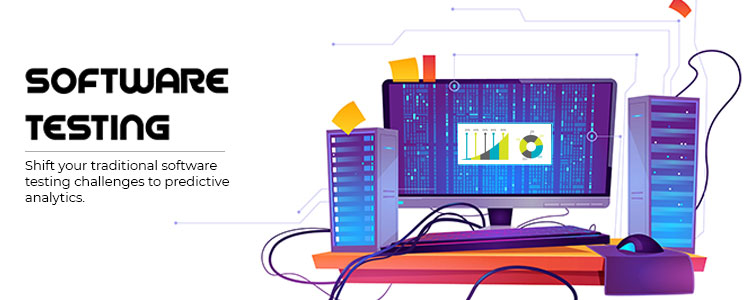
Predictive analytics would shift the direction we design apps dramatically. Through utilizing mathematical methods, empirical evidence from previous tasks will be used to determine how currently your behavior will impact future outcomes. This move towards a more empirical industrial policy between tech professionals has already gained currency. Predictive forecasting allows teams to refine workload and software distribution systems and forecast their capability and pace more precisely, resulting in more efficiency and eventually better software usage.
Predictive analytics are forecasts of unpredictable analytical actions. They incorporate intellect, machine learning, mathematical analytics, mining, and simulation to generate predictions. Validity and acceleration are growing in the area of software testing. Predictive analytics supports all of such things.
Why Predictive Analytics at QA?
They include intelligence, machine learning, mathematical analysis, mining and simulation to generate predictions. Recognition and acceleration are increasing in the field of software testing services. The Inferential analysis supports all such matters.
A large amount of information create from all the assignments acted in the life-cycle testing programming (STLC). Rather than empowering test information to lay inactive, test specialists will misuse it through scientific arrangements and assembly advances to disentangle programming testing. However, the prescient investigation is a developing movement that includes constant survey and correlation with implementable perceptions to permit consistent changes to QA rehearses for improved results.
The advantage of all this is that we can adjust research methodologies by observing consumer interaction trends and can work on the main field by knowing these patterns.
Predictive analytical benefits
1. Consumer research
It is time to adopt a customer-centered research strategy rather than a strictly demand-focused approach. Predictive research permits a customer-based research approach. You will know the views of customers through prescient investigation and allow the test stage client-centered. Through prescient demonstration, organizations will effectively accomplish the advanced transformation.
2. Knowledge is richness
Testing tasks with applications gather information. You establish log logs, and records that lead out different faults if the test may be done. The analysis team understands how by pointing at the issues, the outcomes can improve the client experience.
Examination of groups consolidates test situations to discover issue designs. The information is then mixed with actual computational calculations to identify designs that can reliably predict future disappointments. Programming analyzers can utilize AI calculations to investigate the undertaking archive.
These calculations permit an ideal arrangement suite to accomplish and misleading occasions to identify. Prescient examination upholds the assessment of future breeze through rates dependent on earlier assessment information.
3. Slushy Analysis
Customers are here as kings, we all are aware, and therefore it is necessary to pay heed to the client’s comments. Sentimental research allows considering the input of consumers on different apps and goods in social network tracking. The entire method is faster and smoother in the nostalgic theoretical system.
Consumer demands obtained through proven means; observational methods are helpful to provide perspectives. If an organization pays awareness to consumer reviews and needs to plan the team to solve challenges, it generates a good feeling about the company in the minds of its clients.
4. Better Detention Defect
How does an organization boost its quality? By fault detection! The first step in enhancing efficiency is the identification of defects. Predictive analytics may securely diagnose flaws with the aid of available data. The software team will reach the underlying cause of the errors with predictive techniques.
5. Improves testing quality
The former is the winner by contrasting research performance dependent on item advertising sources of information and continuous client inputs. The prescient examination helps the QA group ensure that the consumer receives the necessary details.
6. Study on what fits well
Predictive analytics lets the team realize what functions and which can be changed to produce optimal outcomes. Predictive analysis lets the employees evaluate what is beneficial and what should be improved to boost implementation performance.
7. Simplifies research operation intuitions
In the software formation and evaluation procedure, a lot of knowledge obtained. It must assess making use of the software. Predictive analysis is even applied to examine further effects on consumer service.
8. Savings capital and effort
Predictive analytics like predictive modeling keep time and resources, where you could easily advertise the commodity with speedy imperfection suspension and improved performance. By analyzing previous manufacturing errors the organization will distinguish what kind of defects are implemented even if the errors are related to current features or innovative technologies.
Check few other benefits of what predictive analytics can offer
- Anticipate test problems at the quite prompt that could prompt unclear upcoming hitches
- Forestall potentials
- Moderate correspondence and coordination issues
- Assume correct right climate and even Vendor
- Improve Preparation, Excellence and Delivery
- Guide on organizational problems
Conclusion
Predictive Analytics lets growth and evaluates many firms to determine the rudimentary causes of any challenges to create strategic choices quickly.
Recent Blogs
Categories



